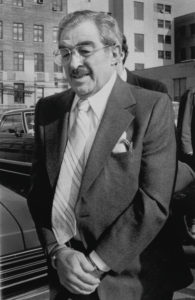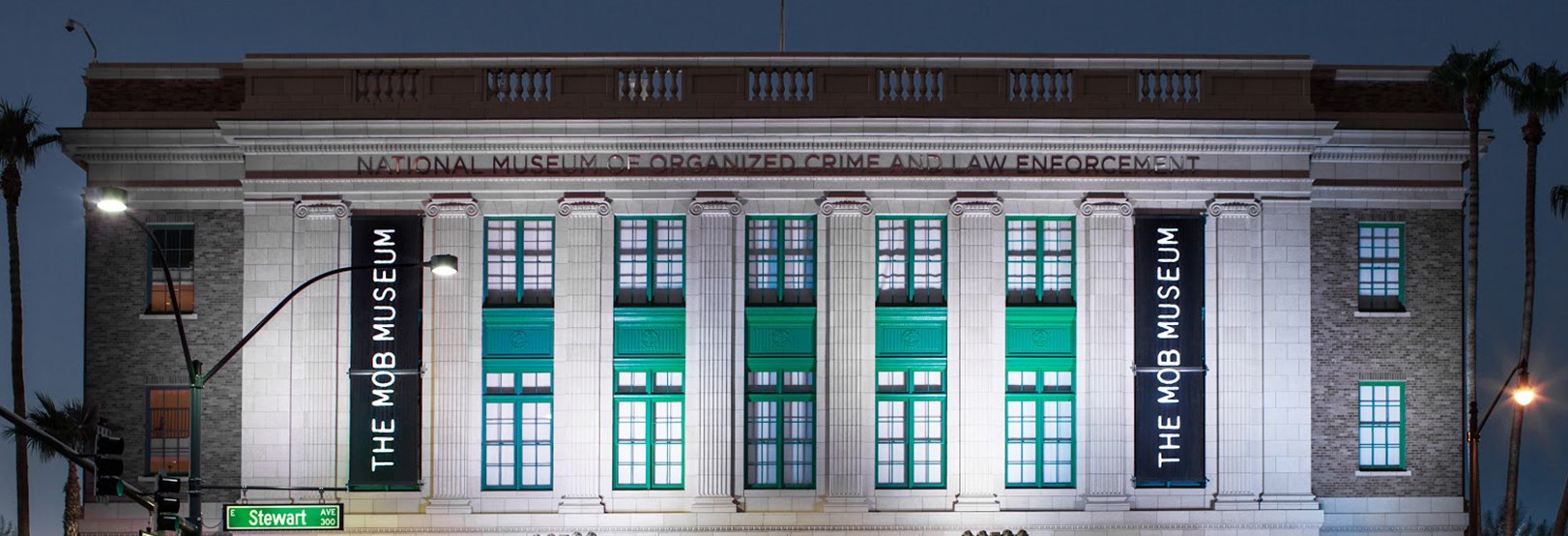
The violent saga of ‘Sally Bugs’
Minor character in The Irishman may have had starring role in real life

During a rainy Tuesday night in New York City’s Little Italy, two assassins in jackets approached their target from behind, knocked him to the ground, apparently without saying a word, then shot him four times in the face and once in the chest.
Leaving the dead man sprawled on the sidewalk in front of the Andrea Doria social club at 165 Mulberry Street, the killers ran north for a short distance, then, according to witnesses, got into a light blue Mercury with New Jersey license plates and drove off.
The victim, wearing a brown leather jacket, plaid shirt and dark slacks, was identified in The New York Times as a 48-year-old resident of Westwood, New Jersey, named Salvatore Briguglio.
As the newspaper noted in its March 23, 1978, story, this was the same Briguglio regarded as a “key suspect” in the disappearance three years earlier of James R. Hoffa, former president of the International Brotherhood of Teamsters.
Hoffa’s disappearance was a big story in those days, and it is back in the news again with the release of Martin Scorsese’s feature film The Irishman.
Hoffa (played by Al Pacino) had been a major figure in the U.S. labor movement but on July 30, 1975, he vanished from the parking lot of a suburban Detroit restaurant, the Machus Red Fox.
After a prison sentence for pension fraud and jury tampering, the 62-year-old Hoffa had been attempting to regain control of the national union from his base in Detroit against the wishes of Mafia hierarchy pleased with the compliant new Teamsters leader, Frank Fitzsimmons. Hoffa had gone to the Machus Red Fox supposedly to resolve differences with high-ranking Mafioso, including Anthony “Tony Pro” Provenzano of New Jersey, a capo in the Genovese crime family.

Hoffa and Provenzano (Stephen Graham in the movie) had been allies but by this time were foes. According to published accounts, the two feuded even while serving in prison together, apparently about Provenzano’s being denied a proper union pension. The two also were at odds, according to veteran reporter Ed Barnes, over Hoffa’s refusal to endorse an East Coast Mafia plan to construct a casino on the Las Vegas Strip near what was then the Dunes but is now the Bellagio. Hoffa earlier had supported the use of union pension funds to build casinos in Las Vegas, but the East Coast plan for a casino near the Dunes never came together.
The 1975 meeting at the Machus Red Fox did not take place, and Hoffa, who had left his year-old, dark-green Pontiac in the parking lot, was never seen again. Seven years later, a judge declared him legally dead. His body has never been recovered.
To this day, neither death — Hoffa’s nor Briguglio’s — has been officially solved, but both killings are being discussed again with the release of The Irishman. The film, now streaming on Netflix, asserts that both were killed by Frank “The Irishman” Sheeran, a former World War II combat soldier and Mafia hit man played by Robert De Niro.
The movie is based on I Heard You Paint Houses, a 2004 book by Sheeran’s former attorney, Charles Brandt. Sheeran died of cancer in 2003 at age 83.
The Scorsese film has generated interest in Hoffa four decades after his disappearance, with new books and podcasts about him coming out in recent months. Other key criminal figures from that era, including Briguglio, also are in the spotlight again.
Though Briguglio did not make himself available to journalists, one who interviewed him face-to-face is Dan Moldea, an investigative reporter who has covered the Hoffa mystery for decades and recently participated in a forum at The Mob Museum on the subject. The panel discussion can be viewed here.
Based on information he has obtained over the years from sources and documents, Moldea says he believes Briguglio, not Sheeran, killed Hoffa. Moldea also is among Hoffa observers who doubt Sheeran killed Briguglio.
Known as “Sally Bugs,” Briguglio had been a business agent in Teamsters Local 560 in Union City, New Jersey, and was aligned with “Tony Pro” Provenzano, a top official in the 13,000-member local.
In his 1978 book The Hoffa Wars and in 2013’s Confessions of a Guerrilla Writer, Moldea provides details regarding Briguglio’s suspected role in the mystery. The reporter even went to Teamsters Local 560 in New Jersey to interview Briguglio and others implicated in Hoffa’s disappearance.
Describing Briguglio as a “short, slim man who wore glasses and spoke with a heavy New Jersey accent,” Moldea noted that Briguglio “did not look like a muscleman.”
In his discussions with Moldea, the “short but wiry” Briguglio, played by Louis Cancelmi in The Irishman, denied having anything to do with Hoffa’s disappearance. (The movie incorrectly asserts that Briguglio was killed in 1979, instead of the actual date, March 21, 1978.)
Moldea and Fox New anchor Eric Shawn, who also appeared at the Mob Museum forum, have teamed up to report on new leads in the Hoffa disappearance and what they suspect is the burial location in New Jersey. Their reporting is available on the Fox Nation subscription website.
Whether Briguglio killed Hoffa or someone else did it — such as Sheeren or, as some believe, a now-deceased Detroit mobster named Anthony “Tony Pal” Palazzolo — is unresolved. Seeking an answer, Shawn has asked for the federal government to release all unredacted files in the investigation.
There also are lingering questions regarding why Briguglio was gunned down. As Jack Goldsmith notes in his 2019 book In Hoffa’s Shadow, rumors were circulating that Briguglio was killed for cooperating with the federal government in a murder trial that Provenzano was facing in the June 1961 killing of a union rival, while others believed Briguglio “may also have been talking about Hoffa.” Goldsmith, a Harvard law professor, is the stepson of Charles “Chuckie” O’Brien (played by Jesse Plemons in the movie), a close Hoffa associate thought at one time to have had a role in the abduction and murder conspiracy. Goldsmith’s book makes the case that O’Brien was not involved.

At the time of Briguglio’s death, he was set to go on trial a few weeks later in Kingston, New York, along with Provenzano and a third suspect, in the kidnapping and killing of Anthony Castellito, a union rival. Briguglio supposedly hit Castellito twice in the head with a lead-filled rubber hose and then helped another man strangle him with a rope, according to The New York Times. Prosecutors alleged Provenzano paid to have the rival killed.
Provenzano, described in a newspaper account as a “short, stocky and ham-fisted man who bore the scars of his young years as an amateur boxer,” later was convicted in the killing. He died in 1988 of a heart attack at age 71 in a hospital near a prison in Lompoc, California.
In a story about Provenzano’s death, New York Times reporter Robert D. McFadden wrote: “Behind his rise and fall lay a shadowy world of associates whose talents lay in beating other men with hammers, in selling labor peace to the trucking industry, in garrotes and guns and the clever use of garbage grinders and incinerators to make enemies disappear.”
The implication is that Briguglio was among those in Provenzano’s “shadowy world of associates.” In addition to being questioned in the Hoffa disappearance and accused in Castellito’s murder, Briguglio had spent 14 months in jail on a counterfeiting conviction. While locked up, he supposedly continued to receive his union pay.
Then, about 10:30 on that March 1978 night in Manhattan’s Little Italy, Salvatore “Sally Bugs” Briguglio was killed on Mulberry Street by hit men firing multiple gunshots.
The next day, interested bystanders still could see the blue-chalk outline that police made to mark where his body came to rest. This spot was only about a block from 129 Mulberry Street, where another mobster, celebrity gangster “Crazy” Joe Gallo (portrayed by Sebastian Maniscalco in the movie), was gunned down six years earlier while celebrating his 43rd birthday at what was then Umberto’s Clam House.
As a scene in The Irishman indicates, Sheeran also claimed to have killed Gallo. This is also highly disputed.
Larry Henry is a veteran print and broadcast journalist. He served as press secretary for Nevada Governor Bob Miller, and was political editor at the Las Vegas Sun and managing editor at KFSM-TV, the CBS affiliate in Northwest Arkansas. Henry taught journalism at Haas Hall Academy in Bentonville, Arkansas, and now is the headmaster at the school’s campus in Rogers, Arkansas.
Feedback or questions? Email blog@themobmuseum.org





